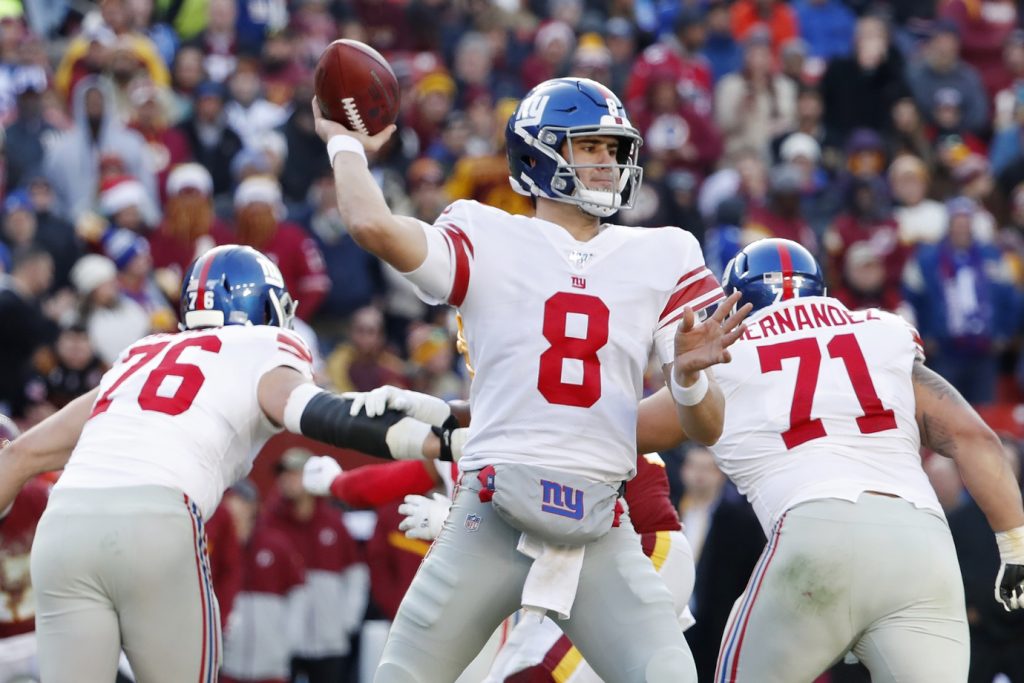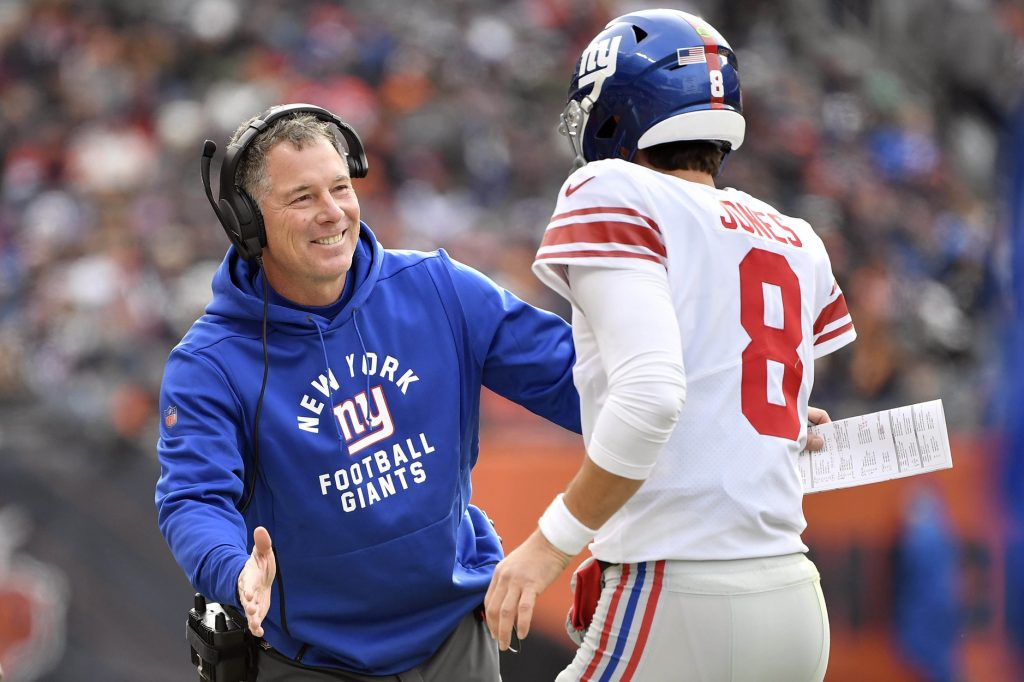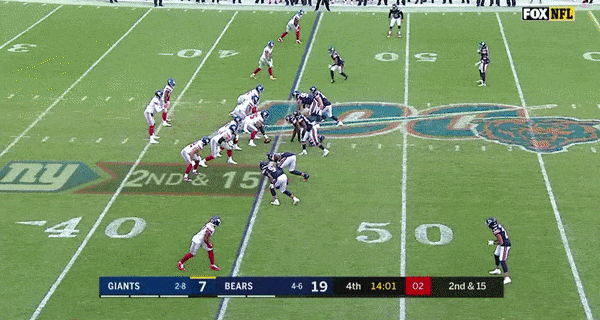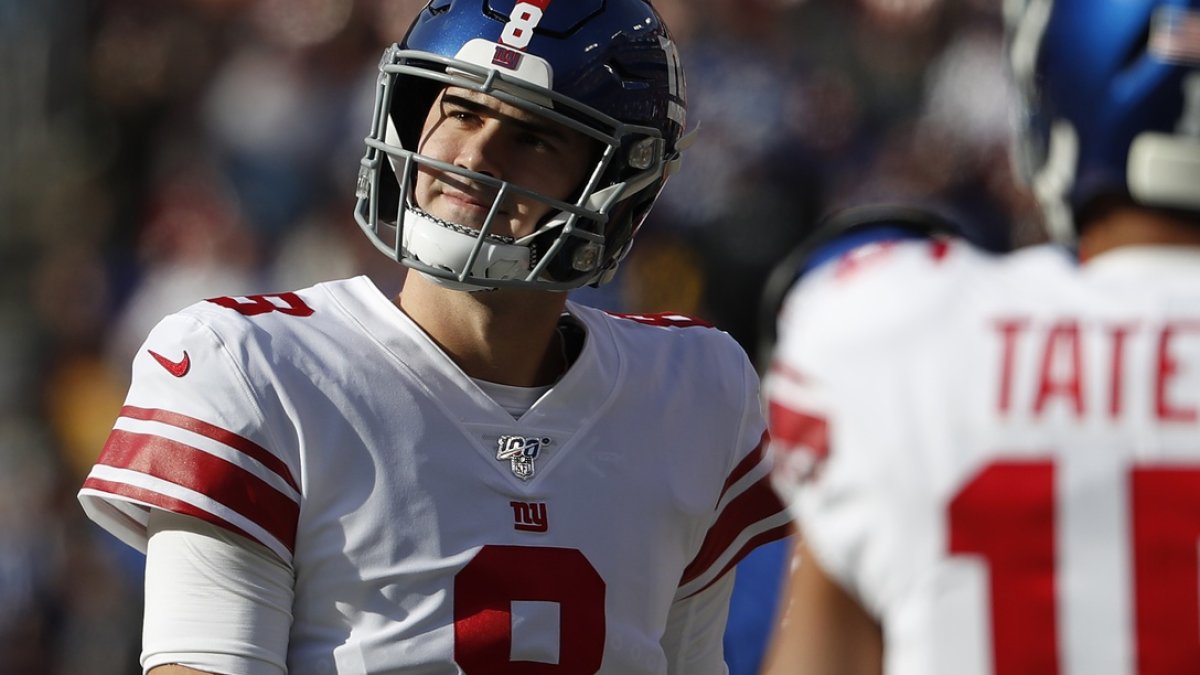New York Giants quarterback Daniel Jones is coming off the best passing performance of his rookie season, in which he racked up 352 yards, five touchdowns and no interceptions in an overtime divisional win against Washington. He has Giants fans eating out of the palm of his hand, and he only endeared himself further when he and Eli Manning were spotted playing drinking games at a Hoboken bar after the game.
In a world without nuance, he is the truth for Giants fans — a shining beacon that lights the way for the franchise going forward. So, as we head toward the close of his rookie season, it’s time to look at exactly what we know about Daniel Jones as an NFL quarterback.
The discussion surrounding Jones is rarely rational or civilized. Battle lines were drawn the moment the Giants drafted him No. 6 overall, when many draft analysts believed him to be a low-first round prospect at best. PFF didn't think he belonged in the first round (though we knew he was always likely to be over-drafted), and the pick was widely criticized across the draft community. From that point onwards, analyzing Jones has been less about articulating truth and being accurate and more about proving one side of the argument was right. After just one game — his debut — the team’s official twitter account was trolling people about their pre-draft takes, and that has been pretty much the tone of the debate all along.
Jones is quickly becoming one of the most interesting quarterbacks in the game because of the way his play breaks down, but there's not really a lot of nuance around him. What follows is an attempt to have that nuanced conversation about who exactly Daniel Jones is and what we can expect him to become.
It is important to note — and to emphasize — that this article is not intended to trash Daniel Jones or argue that he's no good, but simply to place him in the kind of context that much of the black-and-white narrative is missing.

© Geoff Burke-USA TODAY Sports
As you may remember, PFF did not love Jones as a prospect coming out, but the same is true for many players who have gone on to have success, grade well at the NFL level and ultimately prove us wrong. Similarly, being high on players coming into the league hasn’t stopped us leading the criticism of them at the NFL level.
With 32 NFL teams as customers, we cannot afford to have biases within our grading system, and several layers exist to prevent them in the data collection and grading processes. Though it is somewhat logical to assume that we would have an incentive to confirm our pre-draft takes, we have a far stronger incentive to ensure we remain impartial and accurately analyze play to the best of our abilities.
So, with all that being said, what do we actually know about Jones at this point?
Per Elias, Giants QB Daniel Jones becomes first rookie QB in NFL history with five pass TDs, 0 INT and 350 passing yards in a game.
So that's something for Giants fans to hang their hat on …
— Ben Fawkes (@BFawkesESPN) December 22, 2019
The first point to note is that no sequence of quirky combination stats means much of anything. As a general rule of thumb, if you need to tie together three different statistical categories to create your unique record, it means nothing other than you just fabricated a statistic to fit a particular data set. This is the very definition of cherry-picking data, and it's precisely what has been happening after last weekend’s performance.
Even when you dive into the game this weekend, you can see how arbitrary that statistic is as opposed to a true reflection of performance. Fifty-one of those yards came on a bubble screen to Saquon Barkley — a pass that literally any quarterback in the league would be expected to make. The point here is not to discredit Jones — he played well in the game — but simply to point out that the particular arrangement of stats that created a ‘first time in NFL history’ record is truly meaningless.

Of course, his season has been about more than one game. He now has three games with four or more passing touchdowns, which is tied for the most ever by a first-year quarterback. Of course, he also has six games of one passing touchdown, all of which featured at least as many interceptions, so there are multiple ways of looking at that data.
SAMPLE SIZE
A season ago, Baker Mayfield set the rookie record for touchdown passes in a season (27), and Jones could tie that with another four-touchdown performance in Week 17. But with only 11 starts so far this season, you could argue that only injury has kept him from surpassing it already (Mayfield had 13 starts last year).
The fact that he was chasing Mayfield's record speaks volumes, though. Heading into 2019, we thought Baker Mayfield was a borderline top-10 quarterback, primed to kick on and have an excellent season with some big-name additions in Cleveland while comfortably cementing his standing as the best quarterback from his draft class. Mere months later, we’re wondering what happened to Baker, as he has been clearly surpassed by Lamar Jackson in any draft retrospective. Mayfield’s rookie season featured much more play than we will see from Jones by the end of his rookie year, and the sample size still wasn’t enough for anybody to accurately predict his future.
Alright I scraped every single website I could find and here are some stability metrics for ways to measure quarterbacks.
The main message is that PFF grades are good and TD/INT ratio is bad pic.twitter.com/9iHSOLg0Jb
— new-age analytical (@benbbaldwin) December 19, 2019
We exist in a world of zero patience and instant gratification: Social media existing in 280 characters, videos lasting for 15 seconds and quick, click-baiting soundbites. The world wants answers, and it’s not prepared to wait multiple seasons for them, even if it means they’re more likely to be right that way. This is the issue with football analysis in general, particularly when it comes to quarterbacks — the sample size just isn’t big enough for us to reliably know until some time down the line.
The Athletic’s Ben Baldwin recently posted an analysis of various advanced metrics and methods of quarterback evaluation and found that PFF grade has the most predictive power of them all, and yet our grading wasn’t predictive enough to see Baker’s decline or Lamar’s surge coming. Maybe it would have had the sample size been bigger, but NFL seasons don’t allow for that. Herein lies the problem with any Daniel Jones analysis: we might think we’ve seen more than enough to conclude he’s good or bad, but we just haven’t.
Is Daniel Jones good?
Next up is the elephant in the room — the question of whether he has actually played that well. There is no denying that his high-end play has been spectacular, but on a down-to-down basis, the consistency hasn’t been there yet. Obviously, he’s a rookie, so we need to consider his grades on an appropriate curve (he ranks 24th overall among all quarterbacks in PFF grade), but even if we limit ourselves to rookie performances, it’s just not a standout season in overall terms, despite the “record-threatening” perception.
Jones' current PFF grade ranks as the 10th-best grade we have given to a rookie quarterback over the last decade, and it's sandwiched between Sam Bradford and Mike Glennon. It’s not that he’s been bad, but among the 20 passers to play 500-plus snaps in their rookie season, his grade ranks right in the middle.
PFF grade in a vacuum is, of course, not the whole story. Quarterbacks exist as part of a team, with supporting playmakers, pass protection, scheme and coaching all having an influence on that final number, so any analysis of Jones needs to factor them in. Many would argue that Jones has been let down across the board by those other elements and has outperformed expectations because of it. I’m not convinced that’s the case, though it’s certainly true to say that he has been robbed of playing time with some of his top-tier receivers collectively across the season. The combination of Saquon Barkley, Evan Engram, Sterling Shepard, Golden Tate and Darius Slayton has never featured on the field together with Jones at quarterback this season, but he has had enough from each of them to piece together a decent-if-inconsistent group of playmakers.
The biggest criticism his supporters have is with the pass protection. Jones has been sacked 35 times in 11 starts, which is the sixth-highest rate in the NFL. The Giants’ offensive line this season has surrendered 171 total pressures as a unit, the 10th-most in the league, and Nate Solder, in particular, has surrendered the most pressures of any tackle in the game.
Undoubtedly, Jones has not had the best pass-blocking situation in the game. However, quarterbacks control their pressure and sack rate to a huge degree, and the line isn’t as bad as it is being made to look. Jones has the seventh-longest average time to throw in the NFL this year, and he has demonstrated some questionable pocket presence at times to make the pressure worse.
We have charged Jones with eight of the sacks that have been taken (as opposed to charging them to a blocker), and when he has felt pressure collapsing on him, his ball security has been atrocious, seeing him fumble the ball a league-leading 16 times. Not all of those fumbles represent plays where he had a chance of knowing pressure was coming and protecting the ball, but PFF differentiates between those and the plays where he did in the grading, and Jones has a fumble grade of 27.6, the third-worst in the league.
Pat Shurmur has also drawn criticism in some circles, but Shurmur has a history of coaxing good seasons out of quarterbacks, including the career year from Case Keenum with the Minnesota Vikings in 2017 that effectively earned him the Giants' head coaching job. Jones has 153 completions this season on passes that have been charted as open or wide open in PFF’s database, which is only marginally fewer than Lamar Jackson.

© Quinn Harris-USA TODAY Sports
What really leads people astray with Jones is the touchdown to interception ratio. Jones has 23 touchdowns to just 11 interceptions, which is a very healthy ratio, but not necessarily representative of high- and low-end quarterback play. Not all interceptions are bad throws, and not all bad throws end up as interceptions. The same is true for touchdowns, and PFF’s play-by-play grading of every throw a quarterback makes allows us to focus better on what the quarterback actually did, not just the results of the play, which can be far more influenced by the receiver or defenders than it was the passer.
We record big-time throws (think splitting two high safeties on a deep post up the middle) and turnover-worthy plays (a pass late across the middle straight to a waiting linebacker, whether he drops the interception or not) and these statistical categories show a different picture for Jones. He has 16 big-time throws, which ranks 23rd in the NFL (as opposed to 13th in touchdowns), but his turnover-worthy play figure of 28 is the third-highest figure in football behind only Jameis Winston and Kyle Allen, the latter of whom just got benched.

Plays like the one above represent hidden negative that his TD:INT ratio misses. Obviously, all quarterbacks have these plays on their tape, but the point is that the PFF grading system accounts for them all, and Jones is being disproportionally flattered by the box score numbers.
You can, of course, forgive a lot of the negatives if he adds significant positive plays, and while he has done that at times, he's perhaps not done it as many times as people think, which is evidenced by the drop in league ranking if we switch focus from touchdowns to big-time throws.
THE BOTTOM LINE
So, where does this all bring us? Should anyone who disliked the draft pick at the time be eating crow already and deleting their draft takes? Probably not, but it’s definitely fair to say that he’s exceeded many expectations already. I wouldn’t have an argument with anyone who claimed Jones has already shown as much — if not more — than Josh Allen or Sam Darnold, for example.
Jones has been a little above average for a starting rookie quarterback in the past decade, but he's definitely flashed a high-end level of play that makes his average more intriguing than the average of others. Much of his low-end play has also been a careless level of ball security, which should be an easier thing to correct than an ability to pass the football or read coverages.
But, critically, even if you drastically disagree with PFF’s evaluation and analysis of his rookie performance, the most important thing is that we simply haven’t seen enough yet to be able to predict what the future holds for him and the Giants. Maybe he will dramatically improve his play just like Lamar Jackson has, maybe he will decline drastically like second-year Baker Mayfield or Dak Prescott, or maybe this is the baseline for Danny Dimes going forward. Either way, let’s pump the brakes on crowning Daniel Jones and wait and see.



 © 2025 PFF - all rights reserved.
© 2025 PFF - all rights reserved.